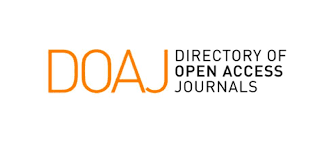Estimation of Groundwater in Oil Palm Plantation Land Based on Resistivity Values
Abstract
Groundwater estimation based on resistivity values ??in oil palm plantations has been successfully carried out. The method used for this estimation is the Wenner-Schlumberger configuration geoelectric method. The number of lines used is two lines with a length of 195 meters each. From the inversion results, the resistivity values ??of lines L1 and L2 are 10.3-607 ?m. From these resistivity values, the soil layers in both paths are suspected of sand, clay sand, and granodiorite weathering. The sand layer is alleged to be an aquifer layer containing groundwater with a resistivity value of 10.3-33.2 ?m. This groundwater is suspected to be at a depth of 1.25-39.4 m for line L1, while in line L2, it is at a depth of 3-24 m. The flow of groundwater follows the topography of each line. The information related to this groundwater can be used for oil palm development or as an alternative to drilled wells.
Downloads
References
[2] Ilamsyah, Jawahir dan M. Akhyar, Pemanfaatan Alat Pendeteksi Kelembaban Tanah dan Suhu Pohon Mangrove Berbasis IoT, J. Tek. Inform., vol. 8, 2022, pp. 59–66.
[3] United States Geological Survey, Groundwater and Aquifers., 2019. https://www.usgs.gov/special-topics/water-science-school/science/aquifers-and-groundwater. [Cited 2024 July 8].
[4] D.K. Singh and N. Kishore, Geoelectrical Sounding to Identify Sub-surface and Groundwater State at Village Banauli, Singrauli District, Madhya Pradesh, India, Nat. Environ. Pollut. Technol., vol. 21, 2022, pp. 1639–1647.
[5] W. Wilopo, M.H. Rachman and D.P.E. Putra, Assessment of Groundwater Resources Potential using Geoelectrical Method and Slug Test in Tegal District, Central Java Province, Indonesia, E3S Web Conf., vol. 200, 2020, pp. 1–5.
[6] I.F. Krisnasiwi, The Mapping of Potential Ground Water using Geoelectrical Measurement of Schlumberger Configuration method in Malata Village, Tana Righu Sub-District, West Sumba District, East Nusa Tenggara Province, J. Phys. Conf. Ser., vol. 2017, 2021, pp. 1–10.
[7] A. Syafnur, H. Jibran, W.D. Tonapa, et al., Investigation of Groundwater Aquifer using Electrical Resistivity Method Wenner-Schlumberger Array Mattoangin Village, Bantimurung District, Maros Regency, J. Geocelebes, vol. 7, 2023, pp. 89–98.
[8] N. Sulaiman, N.A. Ariffin, M.S. Sulaiman, et al., Groundwater Exploration using Electrical Resistivity Imaging (ERI) at Kemahang, Tanah Merah, Kelantan, IOP Conf. Ser. Earth Environ. Sci., vol. 1102, 2022, pp. 1–6.
[9] A.I. Ammar, A.S.A. Abu El-Ata, A.A. Mustafa, et al., Specifying of Aquifer Characteristics using Forward and Inverse Modeling of DC-resistivity and TEM methods, Heliyon, vol. 7, 2021, pp. 1–16.
[10] Y. Febriani, R.A. Rohman, A. Asra, et al., Determination of Groundwater using Geoelectric Methods: Schlumberger Configuration in Rokan Hulu Regency, J. Ilm. Pendidik. Fis. Al-Biruni, vol. 8, 2019, pp. 141–152.
[11] I.K. Sukarasa and I.B.A. Paramarta, Identification of the Groundwater Existence by Geoelectrical Method, Int. J. Phys. Sci. Eng., vol. 4, 2020, pp. 36–42.
[12] M.P. Hadi, R. Salam and R. Achmad, Groundwater Resources Mapping for Small Island using Geoelectrical Technique the Case Study of Ternate Island, Indonesia. J. Geogr., vol 51, 2019, pp. 49-53.
[13] F. Fatimah, A.H.F. Rizqi and W.M.B. Yudhana, Aquifer Mapping Based on Stratigraphic and Geoelectrical Data Analysis in Bedoyo Region, Gunung Kidul Regency, Yogyakarta Special Region, Ris. Geol. dan Pertamb., vol. 31, 2021, pp. 13–26.
[14] N.R. Yanti, F. Arlius, Rusnam, et al., Geoelectrical Investigation the Depth of Groundwater Potential for Irrigation of Paddy Fields, IOP Conf. Ser. Earth Environ. Sci., vol. 515, 2020, pp. 1–7.
[15] I.T. Wiati and E. Wahyuningsih, View of Geoelectric Method for Groundwater Identification in Pangkalarang. J. Civ. Eng. Plan., vol. 4, 2023, pp. 269–276.
[16] J.S. Ejepu, M.O. Jimoh, S. Abdullahi, et al., Geoelectric analysis for Groundwater Potential Assessment and Aquifer Protection in a Part of Shango, North-Central Nigeria, Discov. Water, vol. 4, 2024, pp. 1–26.
[17] D.A. Dayani, W. Wilopo and I. Azwartika, Geoelectric Methods for Groundwater Exploration in the Food Estate Area of Central Sumba Regency, East Nusa Tenggara, Indonesia, Int. Conf. Sustain. Built Environ., vol. 4, 2022, pp. 127–137.
[18] Badan Standardisasi Nasional, SNI 2528:2012 Tata Cara Pengukuran Geolistrik Wenner untuk Eksplorasi Air Tanah, 2012.
[19] D. Darisma, F. Fernanda and M. Syukri, Investigation of Groundwater Potential using Electrical Resistivity Method and Hydraulic Parameters in Lam Apeng, Aceh Besar, Indonesia., J. Geosci. Eng. Environ. Technol., vo. 5, 2020, pp. 185–190.
[20] W. Moulahoum, T. Stigter and M. Hulshof, Sand River Aquifers as a Nature-based Solution of Water Storage for Food Production: the Example of the Shashane River in Southwest Zimbabwe., Geophys. Res. Abstr., vol. 21, 2019 pp. EGU2019-17440-1.
[21] F. Baechler, The Geology and Hydrogeology of Springs on Cape Breton Island, Nova Scotia: an overview, Atl. Geol., vol. 55, 2019, pp. 137–161.
[22] M.H. Loke, Tutorial: 2-D and 3-D Electrical Imaging Surveys, 2024. https://www.geotomosoft.com/downloads.php.[Cited 2024 August 20].
[23] W.M. Telford, L.P. Geldart and R.E. Sheriff, Applied Geophysics, 2nd ed., New York: Cambridge University Press, 1990.
[24] A.R. Asif, S.S. Ali, N. Noreen, et al., Correlation of Electrical Resistivity of Soil with Geotechnical Engineering Parameters at Wattar Area District Nowshera, Khyber Pakhtunkhwa, Pakistan, J. Himal. Earth Sci., vol. 49, 2016, pp. 124–130.
[25] M.A. Massinai, Model of Vertical Resistivity Distribution of Rock Layers in Jeneberang Watershed, Int. J. Basic Appl. Sci. IJBAS-IJENS, vol. 10, 2010, pp. 151–161.
[26] P. Sanyoto dan P.E. Pieter, Peta Geologi Lembar Pontianak/ Nanga Taman Kalimantan, Pusat Penelitian dan Pengembangan Geologi, 1993.
[27] GF Instruments, Advanced Multi-Channel Applications: Automatic Resistivity & IP System, 2000.
[28] M. Triyanto, A. Andriyati, I. Kamila, et al., Pemodelan Pengaruh Nilai Tukar Rupiah Terhadap Dollar Dengan Indeks Harga Saham Gabungan Kompas 100 Menggunakan Metode Gauss Newton, J. Jendela Mat., vol. 2, 2024, hal. 1–10.
[29] Khairunnas dan M. Gusman, Analisis Pengaruh Parameter Konduktivitas, Resistivitas dan TDS Terhadap Salinitas Air Tanah Dangkal pada Kondisi Air Laut Pasang dan Air Laut Surut di Daerah Pesisir Pantai Kota Padang, J. Bina Tambang, vol. 3, 2018, hal. 1751–1760.
[30] Pusat Pendidikan dan Pelatihan Sumber Daya Air dan Konstruksi, Modul Geologi dan Hidrogeologi: Pelatihan Perencanaan Air Tanah, Bandung: Pusat Pendidikan dan Pelatihan Sumber Daya Air dan Konstruksi, 2019.
[31] P. Rubiantoro dan M. Bisri, Identifikasi Sebaran Lapisan Akuifer Dangkal di Kecamatan Pakis Kabupaten Malang, J. Tek. Pengair., vol. 13, 2022, hal. 116–127.
[32] A. Haryanto, Suharyadi dan B. Lanya, Pemanfaatan Air Tanah Dangkal untuk Irigasi Padi Menggunakan Pompa Berbahan Bakar LPG, J. Keteknikan Pertan., vol. 5, 2017, pp. 291–226.
[33] E. Setiawati, P.K. Suprapto dan N. Sunaedi, Pemanfaatan Air Tanah Dangkal Untuk Memenuhi Kebutuhan Domestik Masyarakat Di Sekitar TPA Sampah Kota Banjar, J. Geogr. Educ. Univ. Siliwangi, vol. 3, 2022, hal. 61–65.










